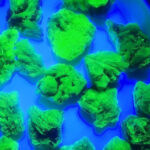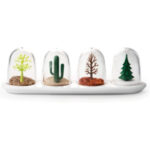
A fascinating collection emerges with the Rare Luminous Gases Elements set, featuring an array of gases—Helium, Neon, Argon, Krypton, Xenon, Nitrogen, Oxygen, Carbon Dioxide, and Air—each encased in a meticulously crafted vessel. These containers, made from high-temperature-resistant borosilicate glass, measure 0.78 inches in diameter and 4.72 inches in length (20mm by 120mm), offering a compact yet durable showcase for the gases within. This design ensures both resilience and clarity, allowing the unique properties of each element to shine through under specific activation methods, making it a captivating tool for enthusiasts and experimenters alike.
Purity defines the creation process of these glass-encased samples, achieved through a rigorous vacuum procedure. Initially, a mechanical vacuum pump extracts air from the glass, followed by high-temperature treatment to purge any lingering impurity gases. A diffusion pump then elevates the vacuum to an exceptional level, preparing the vessel for the introduction of 99.999% pure, electric-light-source-grade rare gas. The high borosilicate glass, chosen for its resistance to heat and chemical stability, prevents contamination, preserving the integrity of the gases for reliable observation and experimentation.
Activation methods unlock the visual splendor of these elements, with each offering distinct effects depending on the technique applied. A Tesla coil, for instance, triggers varied responses across the gases, with each producing a unique glow or pattern—Helium might shimmer differently than Krypton under the same electric field. For precision, an EDM detector provides chromatographic accuracy, revealing subtle differences in excitation that a Tesla coil might blur. Meanwhile, an ion ball yields softer illumination, with Neon standing out as the optimal choice for this method due to its vivid brightness, while Oxygen’s faint gray glow suits darker settings better.
Differences among the gases become evident under specific conditions, offering a spectrum of educational and aesthetic possibilities. Nitrogen and Air, for example, share similar excitation colors, though Air outshines Nitrogen in vividness when sufficiently energized, providing a striking contrast for close study. Oxygen, however, requires more intense activation than others and performs poorly with an ion ball, making it less ideal for that approach—its subtle light gray hue is better appreciated in low-light environments. These nuances make the set a dynamic tool for exploring the behavior of gases under electrical influence.
Versatility and craftsmanship converge in this collection, appealing to collectors, educators, and hobbyists with an interest in chemistry or physics. The high-purity gases, paired with their robust borosilicate enclosures, ensure both safety and longevity, while the range of activation options invites experimentation. Whether glowing under a Tesla coil’s erratic arcs, analyzed with an EDM detector’s precision, or softly lit by an ion ball, these Rare Luminous Gases Elements offer a window into the invisible world of noble and atmospheric gases. It’s a blend of science and spectacle, compact yet brimming with potential for discovery.
Note: You will be redirected to Amazon in your country if there’s an exact or similar product available, else to Amazon.com!













Leave a Reply